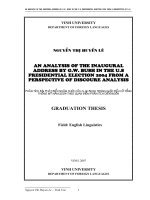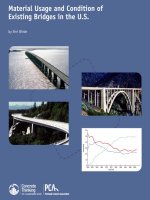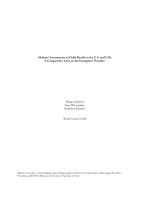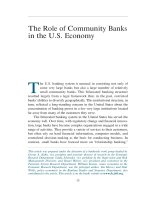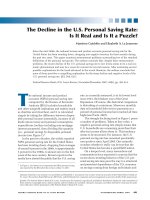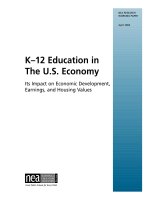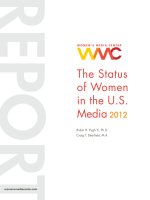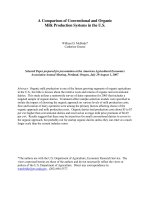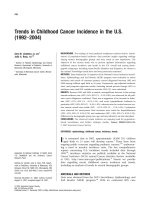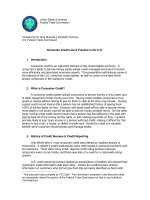Evaluating Research Efficiency in the U.S. Environmental Protection Agency pot
Bạn đang xem bản rút gọn của tài liệu. Xem và tải ngay bản đầy đủ của tài liệu tại đây (546.28 KB, 153 trang )
Committee on Evaluating the Efficiency of Research and Development
Programs at the U.S. Environmental Protection Agency
Committee on Science, Engineering, and Public Policy
Policy and Global Affairs
Board on Environmental Studies and Toxicology
Division on Earth and Life Studies
THE NATIONAL ACADEMIES PRESS 500 Fifth Street, NW Washington, DC 20001
NOTICE: The project that is the subject of this report was approved by the Governing
Board of the National Research Council, whose members are drawn from the councils of
the National Academy of Sciences, the National Academy of Engineering, and the Insti-
tute of Medicine. The members of the committee responsible for the report were chosen
for their special competences and with regard for appropriate balance.
This project was supported by Contract 68-C-03-081 between the National Academy of
Sciences and the U.S. Environmental Protection Agency. Any opinions, findings, conclu-
sions, or recommendations expressed in this publication are those of the authors and do
not necessarily reflect the view of the organizations or agencies that provided support for
this project.
International Standard Book Number-13 978-0-309-11684-8
International Standard Book Number-10 0-309-11684-8
Additional copies of this report are available from
The National Academies Press
500 Fifth Street, NW
Box 285
Washington, DC 20055
800-624-6242
202-334-3313 (in the Washington metropolitan area)
Copyright 2008 by the National Academy of Sciences. All rights reserved.
Printed in the United States of America.
The National Academy of Sciences is a private, nonprofit, self-perpetuating society of
distinguished scholars engaged in scientific and engineering research, dedicated to the
furtherance of science and technology and to their use for the general welfare. Upon the
authority of the charter granted to it by the Congress in 1863, the Academy has a mandate
that requires it to advise the federal government on scientific and technical matters. Dr.
Ralph J. Cicerone is president of the National Academy of Sciences.
The National Academy of Engineering was established in 1964, under the charter of the
National Academy of Sciences, as a parallel organization of outstanding engineers. It is
autonomous in its administration and in the selection of its members, sharing with the
National Academy of Sciences the responsibility for advising the federal government.
The National Academy of Engineering also sponsors engineering programs aimed at
meeting national needs, encourages education and research, and recognizes the superior
achievements of engineers. Dr. Charles M. Vest is president of the National Academy of
Engineering.
The Institute of Medicine was established in 1970 by the National Academy of Sciences
to secure the services of eminent members of appropriate professions in the examination
of policy matters pertaining to the health of the public. The Institute acts under the re-
sponsibility given to the National Academy of Sciences by its congressional charter to be
an adviser to the federal government and, upon its own initiative, to identify issues of
medical care, research, and education. Dr. Harvey V. Fineberg is president of the Institute
of Medicine.
The National Research Council was organized by the National Academy of Sciences in
1916 to associate the broad community of science and technology with the Academy’s
purposes of furthering knowledge and advising the federal government. Functioning in
accordance with general policies determined by the Academy, the Council has become
the principal operating agency of both the National Academy of Sciences and the Na-
tional Academy of Engineering in providing services to the government, the public, and
the scientific and engineering communities. The Council is administered jointly by both
Academies and the Institute of Medicine. Dr. Ralph J. Cicerone and Dr. Charles M. Vest
are chair and vice chair, respectively, of the National Research Council.
www.national-academies.org
v
C
OMMITTEE ON EVALUATING THE EFFICIENCY OF RESEARCH AND
DEVELOPMENT PROGRAMS AT THE
U.S.
ENVIRONMENTAL PROTECTION AGENCY
Members
G
ILBERT S. OMENN (Chair), University of Michigan, Ann Arbor
G
EORGE V. ALEXEEFF, California Environmental Protection Agency, Oakland
R
ADFORD BYERLY, JR., University of Colorado, Boulder
E
DWIN H. CLARK II, Earth Policy Institute, Washington, DC
S
USAN E. COZZENS, Georgia Institute of Technology, Atlanta
L
INDA J. FISHER, E. I. du Pont de Nemours and Company, Wilmington, DE
J.
PAUL GILMAN, Oak Ridge Center for Advanced Studies, Oak Ridge, TN
T.J.
GLAUTHIER, TJG Energy Associates, LLC, Moss Beach, CA
C
AROL J. HENRY, Independent Consultant, Bethesda, MD
R
OBERT J. HUGGETT, College of William and Mary, Seaford, VA
S
ALLY KATZEN, George Mason University School of Law, Fairfax, VA
T
ERRY F. YOUNG, Environmental Defense, Oakland, CA
Staff
R
ICHARD BISSELL, Executive Director, Committee on Science, Engineering,
and Public Policy
D
EBORAH STINE, Associate Director, Committee on Science, Engineering,
and Public Policy (up to August 2007)
E
ILEEN ABT, Senior Program Officer
A
LAN ANDERSON, Consultant Writer
N
ORMAN GROSSBLATT, Senior Editor
J
ENNIFER SAUNDERS, Associate Program Officer
R
AE BENEDICT, Mirzayan Science & Technology Policy Fellow
M
IRSADA KARALIC-LONCAREVIC, Manager, Toxicology Information Center
N
EERAJ P. GORKHALY, Senior Program Assistant
M
ORGAN R. MOTTO, Senior Program Assistant
Sponsor
U.S.
ENVIRONMENTAL PROTECTION AGENCY
vi
C
OMMITTEE ON SCIENCE, ENGINEERING, AND PUBLIC POLICY
Members
G
EORGE WHITESIDES (Chair), Woodford L. and Ann A. Flowers University
Professor, Harvard University, Boston, MA
C
LAUDE R. CANIZARES, Vice President for Research, Massachusetts Institute of
Technology, Cambridge
R
ALPH J. CICERONE (Ex officio), President, National Academy of Sciences,
Washington, DC
E
DWARD F. CRAWLEY, Executive Director, CMI, and Professor, Massachusetts
Institute of Technology, Cambridge
R
UTH A. DAVID, President and Chief Executive Officer, Analytic Services, Inc.,
Arlington, VA
H
AILE T. DEBAS, Executive Director, UCSF Global Health Sciences, Maurice
Galante Distinguished Professor of Surgery, San Francisco, CA
H
ARVEY FINEBERG (Ex officio), President, Institute of Medicine, Washington,
DC
J
ACQUES S. GANSLER, Vice President for Research, University of Maryland,
College Park
E
LSA M. GARMIRE, Professor, Dartmouth College, Hanover, NH
M.
R. C. GREENWOOD (Ex officio), Professor of Nutrition and Internal
Medicine, University of California, Davis
W.
CARL LINEBERGER, Professor of Chemistry, University of Colorado,
Boulder
C.
DAN MOTE, JR. (Ex officio), President and Glenn Martin Institute Professor
of Engineering, University of Maryland, College Park
R
OBERT M. NEREM, Parker H. Petit Professor and Director, Institute for
Bioengineering and Bioscience, Georgia Institute of Technology, Atlanta
L
AWRENCE T. PAPAY, Retired, Sector Vice President for Integrated Solutions,
Science Applications International Corporation, La Jolla, CA
A
NNE C. PETERSEN, Professor of Psychology, Stanford University, Stanford,
CA
S
USAN C. SCRIMSHAW, President, Simmons College, Boston, MA
W
ILLIAM J. SPENCER, Chairman Emeritus, SEMATECH, Austin, TX
L
YDIA THOMAS (Ex officio), Retired, Mitretek Systems, Inc., Falls Church, VA
C
HARLES M. VEST (Ex officio), President, National Academy of Engineering,
Washington, DC
N
ANCY S. WEXLER, Higgins Professor of Neuropsychology, Columbia
University, New York, NY
M
ARY LOU ZOBACK, Vice President Earthquake Risk Applications, Risk
Management Solutions, Inc., Newark, CA
vii
Staff
R
ICHARD BISSELL, Executive Director
D
EBORAH STINE, Associate Director (up to August 2007)
M
ARION RAMSEY, Administrative Coordinator
N
EERAJ P. GORKHALY, Senior Program Assistant
viii
B
OARD ON ENVIRONMENTAL STUDIES AND TOXICOLOGY
Members
J
ONATHAN M. SAMET (Chair), Johns Hopkins University, Baltimore, MD
R
AMON ALVAREZ, Environmental Defense Fund, Austin, TX
J
OHN M. BALBUS, Environmental Defense Fund, Washington, DC
D
ALLAS BURTRAW, Resources for the Future, Washington, DC
J
AMES S. BUS, Dow Chemical Company, Midland, MI
R
UTH DEFRIES, University of Maryland, College Park
C
OSTEL D. DENSON, University of Delaware, Newark
E.
DONALD ELLIOTT, Willkie Farr & Gallagher LLP, Washington, DC
M
ARY R. ENGLISH, University of Tennessee, Knoxville
J.
PAUL GILMAN, Oak Ridge Center for Advanced Studies, Oak Ridge, TN
S
HERRI W. GOODMAN, Center for Naval Analyses, Alexandria, VA
J
UDITH A. GRAHAM (Retired), Pittsboro, NC
W
ILLIAM P. HORN, Birch, Horton, Bittner and Cherot, Washington, DC
W
ILLIAM M. LEWIS, JR., University of Colorado, Boulder
J
UDITH L. MEYER, University of Georgia, Athens
D
ENNIS D. MURPHY, University of Nevada, Reno
P
ATRICK Y. O’BRIEN, ChevronTexaco Energy Technology Company,
Richmond, CA
D
OROTHY E. PATTON, (Retired) U.S. Environmental Protection Agency,
Chicago, IL
D
ANNY D. REIBLE, University of Texas, Austin
J
OSEPH V. RODRICKS, ENVIRON International Corporation, Arlington, VA
A
RMISTEAD G. RUSSELL, Georgia Institute of Technology, Atlanta
R
OBERT F. SAWYER, University of California, Berkeley
K
IMBERLY M. THOMPSON, Massachusetts Institute of Technology, Cambridge
M
ONICA G. TURNER, University of Wisconsin, Madison
M
ARK J. UTELL, University of Rochester Medical Center, Rochester, NY
C
HRIS G. WHIPPLE, ENVIRON International Corporation, Emeryville, CA
L
AUREN ZEISE, California Environmental Protection Agency, Oakland
Senior Staff
J
AMES J. REISA, Director
D
AVID J. POLICANSKY, Scholar
R
AYMOND A. WASSEL, Senior Program Officer for Environmental Studies
E
ILEEN N. ABT, Senior Program Officer for Risk Analysis
S
USAN N.J. MARTEL, Senior Program Officer for Toxicology
K
ULBIR BAKSHI, Senior Program Officer
E
LLEN K. MANTUS, Senior Program Officer
R
UTH E. CROSSGROVE, Senior Editor
ix
O
THER REPORTS OF THE
C
OMMITTEE ON SCIENCE, ENGINEERING, AND PUBLIC POLICY
Advanced Research Instrumentation and Facilities (2006)
Beyond Bias and Barriers: Fulfilling the Potential of Women in Academic
Science and Engineering (2006)
Rising Above the Gathering Storm: Energizing and Employing America for a
Brighter Economic Future (2005)
Policy Implications of International Graduate Students and Postdoctoral
Scholars in the United States (2005)
Setting Priorities for NSF-sponsored Large Research Facility Projects (2004)
Facilitating Interdisciplinary Research (2004)
Science and Technology in the National Interest: Ensuring the Best Presidential
and Federal Advisory Committee and Technology Appointments (2004)
Electronic Scientific, Technical and Medical Journal Publishing and ITS
Implications (2004)
Observations on the President’s Fiscal Year 2003 Federal Science and
Technology Budget (2003)
Implementing the Government Performance and Results Act for Research:
A Status Report (2003)
Scientific and Medical Aspects of Human Reproductive Cloning (2002)
Observations on the President’s Fiscal Year 2002 Federal Science and
Technology Budget (2002)
Experiments in International Benchmarking of U.S. Research Fields (2000)
Observations on the President’s Fiscal Year 2001 Federal Science and
Technology Budget (2000)
Enhancing the Postdoctoral Experience for Scientists and Engineers: A Guide
for Postdoctoral Scholars, Advisors, Institutions, Funding Organizations,
and Disciplinary Societies (2000)
Science and Technology in the National Interest: The Presidential Appointment
Process (2000)
Evaluating Federal Research Programs: Research and the Government
Performance and Results Act (1999)
Capitalizing on Investments in Science and Technology (1999)
Observations on the President’s Fiscal Year 2000 Federal Science and
Technology Budget (1999)
Observations on the President’s Fiscal Year 1999 Federal Science and
Technology Budget (1998)
Adviser, Teacher, Role Model, Friend: On Being a Mentor to Students in
Science and Engineering (1997)
Proceedings of the National Convocation on Science and Engineering Doctoral
Education (1996)
Careers in Science and Engineering: A Student Planning Guide to Grad School
and Beyond (1996)
x
An Assessment of the National Science Foundation’s Science and Technology
Centers Program (1996)
Allocating Federal Funds for Science and Technology (1995)
Reshaping the Graduate Education of Scientists and Engineers (1995)
On Being a Scientist: Responsible Conduct in Research (1995)
Major Award Decisionmaking at the National Science Foundation (1994)
Science, Technology, and the Federal Government: National Goals for a New
Era (1993)
Responsible Science Volume 2: Background Papers and Resource Documents
(1993)
Responsible Science Volume 1: Ensuring the Integrity of the Research Process
(1992)
Policy Implications of Greenhouse Warming: Mitigation, Adaptation, and the
Science Base (1991)
Copies of these reports may be ordered from the National Academies Press
(800) 624-6242 or (202) 334-3313
www.nap.edu
xi
O
THER REPORTS OF THE
B
OARD ON ENVIRONMENTAL STUDIES AND TOXICOLOGY
Respiratory Diseases Research at NIOSH (2008)
Hydrology, Ecology, and Fishes of the Klamath River Basin (2008)
Estimating Mortality Risk Reduction and Economic Benefits from Controlling
Ozone Air Pollution (2008)
Applications of Toxicogenomic Technologies to Predictive Toxicology and Risk
Assessment (2007)
Models in Environmental Regulatory Decision Making (2007)
Toxicity Testing in the Twenty-first Century: A Vision and a Strategy (2007)
Sediment Dredging at Superfund Megasites: Assessing the Effectiveness (2007)
Environmental Impacts of Wind-Energy Projects (2007)
Scientific Review of the Proposed Risk Assessment Bulletin from the Office of
Management and Budget (2007)
Assessing the Human Health Risks of Trichloroethylene: Key Scientific Issues
(2006)
New Source Review for Stationary Sources of Air Pollution (2006)
Human Biomonitoring for Environmental Chemicals (2006)
Health Risks from Dioxin and Related Compounds: Evaluation of the EPA Re-
assessment (2006)
Fluoride in Drinking Water: A Scientific Review of EPA’s Standards (2006)
State and Federal Standards for Mobile-Source Emissions (2006)
Superfund and Mining Megasites—Lessons from the Coeur d’Alene River Ba-
sin (2005)
Health Implications of Perchlorate Ingestion (2005)
Air Quality Management in the United States (2004)
Endangered and Threatened Species of the Platte River (2004)
Atlantic Salmon in Maine (2004)
Endangered and Threatened Fishes in the Klamath River Basin (2004)
Cumulative Environmental Effects of Alaska North Slope Oil and Gas Devel-
opment (2003)
Estimating the Public Health Benefits of Proposed Air Pollution Regulations
(2002)
Biosolids Applied to Land: Advancing Standards and Practices (2002)
The Airliner Cabin Environment and Health of Passengers and Crew (2002)
Arsenic in Drinking Water: 2001 Update (2001)
Evaluating Vehicle Emissions Inspection and Maintenance Programs (2001)
Compensating for Wetland Losses Under the Clean Water Act (2001)
A Risk-Management Strategy for PCB-Contaminated Sediments (2001)
Acute Exposure Guideline Levels for Selected Airborne Chemicals (six
volumes, 2000-2008)
Toxicological Effects of Methylmercury (2000)
Strengthening Science at the U.S. Environmental Protection Agency (2000)
Scientific Frontiers in Developmental Toxicology and Risk Assessment (2000)
xii
Ecological Indicators for the Nation (2000)
Waste Incineration and Public Health (2000)
Hormonally Active Agents in the Environment (1999)
Research Priorities for Airborne Particulate Matter (four volumes, 1998-2004)
The National Research Council’s Committee on Toxicology: The First 50
Years (1997)
Carcinogens and Anticarcinogens in the Human Diet (1996)
Upstream: Salmon and Society in the Pacific Northwest (1996)
Science and the Endangered Species Act (1995)
Wetlands: Characteristics and Boundaries (1995)
Biologic Markers (five volumes, 1989-1995)
Science and Judgment in Risk Assessment (1994)
Pesticides in the Diets of Infants and Children (1993)
Dolphins and the Tuna Industry (1992)
Science and the National Parks (1992)
Human Exposure Assessment for Airborne Pollutants (1991)
Rethinking the Ozone Problem in Urban and Regional Air Pollution (1991)
Decline of the Sea Turtles (1990)
Copies of these reports may be ordered from the National Academies Press
(800) 624-6242 or (202) 334-3313
www.nap.edu
xiii
Preface
In an effort to ensure the wise use of taxpayers’ money, the federal gov-
ernment has undertaken major initiatives to evaluate the performance and results
of federally funded programs, including research and development (R&D) pro-
grams. The initiatives include the Government Performance and Results Act of
1993 and the Office of Management and Budget (OMB) Program Assessment
Rating Tool (PART), developed in 2002. The latter was designed in the context
of “performance budgeting” and “performance measurement” and focused on
evaluating the efficiency of programs.
Evaluation of R&D programs has proved challenging for federal agencies,
including the Environmental Protection Agency (EPA), a mission-oriented
agency with a substantial research component. All agencies have experienced
difficulties in complying with the PART requirements to measure the efficiency
of their research, to use outcome-based metrics in doing so, and to achieve and
quantitate annual efficiency improvements.
In 2006, EPA asked the National Academies for assistance in developing
better assessment tools to comply with PART, with emphasis on efficiency. The
Academies’ Committee on Science, Engineering, and Public Policy (COSEPUP)
and the National Research Council Board on Environmental Studies and Toxi-
cology (BEST) convened the Committee on Evaluating the Efficiency of Re-
search and Development Programs at the U.S. Environmental Protection
Agency.
In this report, the committee addresses the efficiency measures now used
for federally funded R&D programs and evaluates whether they are sufficient
and are based on outcomes, not only inputs and outputs. The committee provides
principles that it hopes will guide the development of efficiency measures for
federally funded R&D programs and makes recommendations about efficiency
measures for EPA’s basic and applied R&D programs and about OMB’s review
process.
The committee gratefully acknowledges the following for making presen-
tations to the committee: Diana Espinosa, Daren Wong, Brian Kleinman, and
Kevin Neyland, of OMB; Marcus Peacock, Hugh Tilson, Phillip Juengst, Lori
Kowalski, of EPA; Bill Valdez, Darrell Beschen, and Brian Card, of the De-
partment of Energy; Pat Tsuchitani, of the National Science Foundation; Deb-
xiv
Preface
orah Duran, of the National Institutes of Health; Julie Pollitt, of the National
Aeronautics and Space Administration; Raymond Sinclair, of the National Insti-
tute for Occupational Safety and Health; George Daston, of the Procter & Gam-
ble Company; Joseph Kenney and Bernice Rogowitz, of IBM Global Business
Services; James Bus, of Dow Chemical Company; and Patrick Atkins, retired
from Alcoa.
The committee is grateful for the assistance of the National Research
Council staff in preparing this report. Staff members who contributed to the ef-
fort are Richard Bissell, project director from August 2007 and director of
COSEPUP; Deborah Stine, project director (up to August 2007); Eileen Abt,
senior program officer; James Reisa, director of BEST; Alan Anderson, consult-
ant science writer; Jennifer Saunders, associate program officer; Rae Benedict,
Mirzayan Science & Technology Policy Fellow; Norman Grossblatt, senior edi-
tor; Mirsada Karalic-Loncarevic, manager of the Toxicology Information Cen-
ter; and Neeraj Gorkhaly and Morgan Motto, senior project assistants.
I especially thank my colleagues on the committee for their engagements
in the contentious issues underlying our charge and for what we believe are con-
structive principles and feasible recommendations that have emerged from our
deliberations and the iterative development of this report.
Gilbert S. Omenn, Chair
Committee on Evaluating the Efficiency of
Research and Development Programs at the
U.S. Environmental Protection Agency
xv
Acknowledgment of Review Participants
This report has been reviewed in draft form by persons chosen for their
diverse perspectives and technical expertise in accordance with procedures ap-
proved by the National Research Council’s Report Review Committee. The pur-
pose of the independent review is to provide candid and critical comments that
will assist the institution in making its published report as sound as possible and
to ensure that the report meets institutional standards of objectivity, evidence,
and responsiveness to the study charge. The review comments and draft manu-
script remain confidential to protect the integrity of the deliberative process. We
thank the following for their review of the report: Irwin Feller, Pennsylvania
State University; Haren S. Gandhi, Ford Motor Company; Bernard D. Goldstein,
University of Pittsburgh; Victoria F. Haynes, Research Triangle Institute; Mar-
tha A. Krebs, California Energy Commission; James H. Johnson, Jr., Howard
University; Genevieve M. Matanoski, Johns Hopkins University; Shelley H.
Metzenbaum, University of Maryland School of Public Policy; and David Trin-
kle, University of California, Berkeley.
Although the reviewers listed above have provided many constructive
comments and suggestions, they were not asked to endorse the conclusions or
recommendations, nor did they see the final draft of the report before its release.
The review of the report was overseen by John F. Ahearne, Sigma Xi, The Sci-
entific Research Society, and Alan Schriesheim, Argonne National Laboratory.
Appointed by the National Research Council, they were responsible for making
certain that an independent examination of the report was carried out in accor-
dance with institutional procedures and that all review comments were carefully
considered. Responsibility for the final content of this report rests entirely with
the author committee and the institution.
xvii
Contents
SUMMARY 3
1 INTRODUCTION: THE GOVERNMENT PERFORMANCE AND
RESULTS ACT, THE PROGRAM ASSESSMENT RATING TOOL,
AND THE ENVIRONMENTAL PROTECTION AGENCY 11
Inherent Difficulties in Evaluating Research, 11
Research Terms at the Environmental Protection Agency, 12
Evaluating Research under the Government Performance and Results
Act, 13
The Rationale and Function of the Program Assessment Rating Tool, 14
The Application of the Program Assessment Rating Tool to Research, 14
The Organization and Performance of Research and Development
at the Environmental Protection Agency, 16
Uses of Results of Environmental Protection Agency Research, 18
Summary, 18
References, 19
2 EFFICIENCY METRICS USED BY THE ENVIRONMENTAL
PROTECTION AGENCY AND OTHER FEDERAL RESEARCH
AND DEVELOPMENT PROGRAMS 21
Evaluating Research and Development, 22
The Program Assessment Rating Tool and Efficiency, 22
Applying Efficiency to Inputs, Outputs, and Outcomes, 22
The Program Assessment Rating Tool Grading System, 23
The Use of “Expert Review” at the Environmental Protection Agency, 24
Emerging Issues, 27
Metrics Proposed by the Environmental Protection Agency, 27
Metrics That Did Not Pass the Program Assessment Rating Tool
Process, 29
The Consequences of a “No” Answer to a Program Assessment Rating
Tool Question, 30
Evaluation Mechanisms Used by Other Agencies, 31
Methods Used by Industry, 35
Summary, 35
References, 36
xviii Contents
3 ARE THE EFFICIENCY METRICS USED BY FEDERAL
RESEARCH AND DEVELOPMENT PROGRAMS
SUFFICIENT AND OUTCOME-BASED? 38
Attempting to Evaluate Efficiency in Terms of Ultimate Outcomes, 38
Placing “Research Efficiency” in Perspective, 40
Process Efficiency and Investment Efficiency, 41
What Are “Sufficient” Metrics of Process Efficiency? 42
A Critique of the Efficiency Metrics Used by Federal Research
Programs, 44
Factors that Reduce the Efficiency of Research, 47
Evaluating Research Efficiency in Industry, 48
The Shortcomings of Retrospective Review, 49
Summary and Recommendations, 49
References, 50
4 A MODEL FOR EVALUATING RESEARCH AND
DEVELOPMENT PROGRAMS 52
Summary, 56
References, 56
5 FINDINGS, PRINCIPLES, AND RECOMMENDATIONS 58
Findings, 59
Principles, 60
Recommendations, 65
Additional Recommendation for the Office of Management
and Budget, 67
References, 68
APPENDIX A: BIOGRAPHIC INFORMATION ON THE
COMMITTEE ON EVALUATING THE EFFICIENCY OF
RESEARCH AND DEVELOPMENT PROGRAMS AT THE
U.S. ENVIRONMENTAL PROTECTION AGENCY 69
APPENDIX B: EVALUATING THE EFFICIENCY OF
RESEARCH AND DEVELOPMENT PROGRAMS AT THE
U.S. ENVIRONMENTAL PROTECTION AGENCY:
WORKSHOP SUMMARY 75
APPENDIX C: PROGRAM ASSESSMENT RATING TOOL
(PART) QUESTIONS 86
APPENDIX D: THE ENVIRONEMENTAL PROTECTION
AGENCY’S STRATEGIC AND MULTI-YEAR
PLANNING PROCESS 90
xix
Contents
APPENDIX E: AGENCY AND INDUSTRY
EFFICIENCY MEASURES 95
APPENDIX F: DRAFT BOARD OF SCIENTIFIC COUNSELORS
HANDBOOK FOR SUBCOMMITTEE CHAIRS: DRAFT
PROPOSED CHARGE QUESTIONS FOR BOSC REVIEWS 109
APPENDIX G: OMB’S RESEARCH AND DEVELOPMENT
PROGRAM INVESTMENT CRITERIA 113
APPENDIX H: CHARGE TO THE BOSC SUBCOMMITTEE
ON SAFE PESTICIDES/SAFE PRODUCTS RESEARCH 119
APPENDIX I: PART GUIDANCE ON EFFICIENCY MEASURES 128
BOXES, FIGURES, AND TABLES
BOXES
1-1 Distribution of PART Scores, 15
1-2 How PART Questions Are Scored, 16
2-1 BOSC: An Example of Expert Review, 28
I-1 Measures and PARTWeb, 129
I-2 Question Linkages, 131
FIGURES
4-1 EPA research presented as a logical model, 54
TABLES
E-1 Agency and Industry Efficiency Measures, 96
3
Summary
The federal government has long sought effective tools to evaluate the
performance and results of publicly funded programs, including research and
development (R&D) programs, to ensure the wise use of taxpayers’ money. To
that end, Congress passed the Government Performance and Results Act in
1993, and the Office of Management and Budget (OMB) designed the Program
Assessment Rating Tool (PART) in 2002.
Evaluation of R&D programs has proved to be challenging for federal
agencies. In particular, they have experienced difficulties in complying with the
PART requirements to measure the efficiency of their research, to use outcome-
based metrics in doing so, and to achieve annual efficiency improvements.
In 2006, the U.S. Environmental Protection Agency (EPA) asked the Na-
tional Academies for independent assistance in developing better assessment
tools to comply with PART. The Academies’ Committee on Science, Engineer-
ing, and Public Policy (COSEPUP) and the National Research Council (NRC)
Board on Environmental Studies and Toxicology (BEST) oversaw the appoint-
ment of the Committee on Evaluating the Efficiency of Research and Develop-
ment Programs at the U.S. Environmental Protection Agency and charged it to
answer the following questions:
• What efficiency measures are currently used for EPA R&D programs
and other federally funded R&D programs?
• Are these efficiency measures sufficient? Are they outcome-based?
• What principles should guide the development of efficiency measures
for federally funded R&D programs?
• What efficiency measures should be used for EPA’s basic and applied
R&D programs?
Through a series of information-gathering steps, including discussions
with OMB and EPA and a public workshop attended by representatives of re-
4
Evaluating Research Efficiency in EPA
search-intensive agencies
1
and industries, the committee evaluated how EPA
and other agencies were attempting to comply with PART. The committee fo-
cused its deliberations on several fundamental issues posed by the charge ques-
tions, including
1. How—and why—should research be evaluated in terms of efficiency?
2. What is a “sufficient” measure of efficiency?
3. What measures of efficiency are “outcome-based,” and should they be?
In its discussion the committee uses the terms inputs, outputs, and out-
comes as defined by OMB, except as modified and discussed below:
• Inputs are agency resources—such as funding, facilities, and human
capital—that support research.
• Outputs are activities or accomplishments delivered by research pro-
grams, such as research findings, papers published, exposure methods developed
and validated, and research facilities built or upgraded.
• Outcomes are the benefits resulting from a research program, which can
be short-term, such as an improved body of knowledge or a comprehensive sci-
ence assessment, or long-term, such as lives saved or enhancement of air qual-
ity, that may be based on research activities or informed by research but that
require additional activities by many others. The committee distinguishes these
two types of outcomes using the terms, intermediate outcomes and ultimate or
end outcomes.
2
QUESTION 1
With respect to the question, “How—and why—should research be evalu-
ated in terms of efficiency?”, the committee suggests that some of the frustration
expressed by federal research-intensive agencies in complying with PART de-
rives from confusion over the concept of “efficiency.” From its review of the
OMB PART guidance and efficiency measures used by EPA and other federal
agencies, the committee concludes that two conceptually different kinds of effi-
ciency are integral to the execution and evaluation of R&D programs. The
committee distinguished between investment efficiency and process efficiency.
Investment efficiency focuses on portfolio management, including the need
to identify the most promising lines of research for achieving desired outcomes.
1
The term research-intensive is used to describe agencies for which research is an es-
sential even if not necessarily dominant aspect of the mission. For example, research is
important at EPA but is not its primary function, as is the case for the National Institutes
of Health and the National Science Foundation.
2
The committee acknowledges that the NRC Committee for the Review of NIOSH
Research Program has used the term end outcomes.
